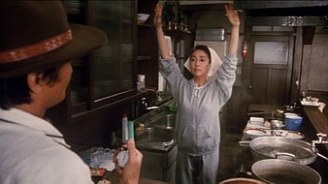Gun and Goro help Tampopo train to prepare the perfect bowl of ramen.
Itami’s film, Tampopo, focuses on the fusion of Japanese and Western culture, combining various different genres together to create a “Ramen Western”. This scene follows Goro and Gun as they help both train Tampopo and teach her the art of making ramen.
The mis-en-scene and other directorial techniques employed in this film create a connection to Western movie genres, and ultimately the “Ramen Western”. This scene in particular is comparable to Stallone’s Rocky Balboa in that both Rocky and Tampopo are everyday figures – underdogs even – who train intensively for ultimate success. The tasks that Goro and Gun present to Tampopo as training mimic the same training process Rocky went through. However, while Rocky trains to fight in the ring, Tampopo trains to prepare the perfect bowl of ramen. Because Tampopo is presented with such an intensive training plan, the audience gets a feel for the satire of Western culture and movies.
For instance, Goro and Gun are both costumed in cowboy hats and long-sleeve collared shirts – the stereotypical Western getup, which establishes the influences and ultimate satire of Western culture. The connection to Rocky Balboa is once again brought up as we see Tampopo dressed in track clothing – much like the attire Rocky would wear while training for the boxing ring. Compositionally, the camera switches off between facial close-ups and Tampopo’s hands as she prepares the ramen bowls. The facial close-ups allow the audience to better grasp the intensity and concentration dedicated to the art of ramen. The close-up shots of Tampopo’s hands preparing each ramen bowl intensify the noodle-making process. The intensity and deep concentration – overall exaggerated emotions – shown on the characters’ faces provides the audience with the satire of the West.
Many of the directorial choices made in this scene revolve around the idea of time and urgency. Such intensity of the training scene imitates that in Rocky Balboa and ultimately satirizes Western culture. Much of the scene has been under cranked, speeding up the actions on the screen. While Tampopo portions out ramen noodles to bowls and prepares the soup, the fast motion incites a feeling of chaos and urgency within the home audience. In the screenshot selected, one of the truck men holds a stopwatch, as Tampopo gets ready for her next task. The image of the stopwatch reconfirms and the diegetic sound of the stopwatch’s ticking reconfirms the idea of urgency and time. The ticking gets much louder and faster as faster as the scene progresses, intensifying the moment. Even the transitions between training tasks illustrate the idea of time, as a new scene opens in spiral reminiscent of a clock hand moving around the face. Both classical and marching soundtracks play in the background of the scene, which demonstrates Western impacts upon Japanese culture.
Throughout much of Itami’s Tampopo, Western culture is incorporated into the Japanese culture. Though Itami acknowledges these influences upon Japanese culture, he integrates the West so excessively, providing his own commentary on these influences. The exaggeration allows for the audience to understand more negative aspects of Western influence. Through this film, Itami pushes his audience to contemplate the overall effect of Western influences upon the Japanese culture.











